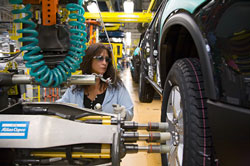Changing the Auto Industry from the Wheels Up
The problems of the U.S. auto industry call for radical solutions.
This is a web-only article from the website of Dollars & Sense: The Magazine of Economic Justice available at http://www.dollarsandsense.org

This is a web-only article, available only at www.dollarsandsense.org.
Subscribe Now
at a 30% discount.
Intro | Pt. I | Pt. II | Pt. III | Pt. IV | Pt. V | Pt. VI | Full article

Photo by Jim West
Introduction
The “Big Three” U.S. auto companies are not facing a crisis—they are facing multiple interrelated crises at once. Chrysler, General Motors, and Ford have posted tens of billions in losses over the last few years. They suffer from chronic overcapacity, producing more cars than they can sell, and have ended up selling cars at a loss. [Note 1] Their cars are widely viewed as lagging behind those of international competitors in quality, styling, and reliability. They have focused on fighting fuel-efficiency standards rather than developing new, fuel-efficient vehicles. [Note 2] They have bet heavily on large, gas-guzzling models and are playing catch-up Toyota and Honda in the development of hybrid cars. [Note 3] They face significant cost disadvantages compared to their main competitors, mainly due to retiree health and pension “legacy costs.” [Note 4] And, on top of all this, a deep recession has hammered car sales. [Note 5]
Already operating in the red before last year, the Big Three have been burning through billions in cash reserves during the current recession. General Motors, having posted losses every year since 2005, lost over $30 billion in 2008. [Note 6] It has reported that, in the first quarter of 2009, it lost another $6 billion (and depleted its cash reserves by over $10 billion). [Note 7] Ford has posted losses since 2006, including about $15 billion in 2008. [Note 8] Chrysler lost $8 billion last year. [Note 9] With their companies teetering on the edge of bankruptcy, GM and Chrysler executives appeared before Congress last November asking for a government bailout. In December, the Bush administration announced $13.4 billion in loans for GM and $4 billion for Chrysler. [Note 10](Since then, both companies have asked for billions more.) In April, the Obama administration offered additional loans of one-half billion to Chrysler and up to $5 billion to GM. [Note 11]Lacking private sources of financing, the two companies have managed to stay in business this long thanks only to the government loans.
The government has required both companies to submit restructuring plans, including concessions from workers and creditors, as a condition of the bailouts. [Note 12]At the end of March, the Obama administration rejected the submitted plans as inadequate. It gave Chrysler 30 days more to conclude a takeover deal with Italian auto giant Fiat, while GM got 60 days to submit a new restructuring plan. [Note 13]In late April, Chrysler appeared to have a deal with Fiat, with the Italian automaker set to take over operations and receive 20% of the company’s stock (with a possible future increase to 35%). A United Auto Workers (UAW) retiree health-care trust would own 55% of the stock. [Note 14]The UAW accepted new concessions on wages and benefits, while the company’s major creditors agreed to cancel billions in debt for about a third of its face value (plus less than 10% of the company’s stock). [Note 15]When some creditors balked at the plan, however, the company filed for bankruptcy. [Note 16]Meanwhile, GM proposed a restructuring plan in which the federal government would own 50% of the stock (in exchange for the cancellation of about $10 billion in company debt), and the UAW retiree health-care trust nearly 40%, leaving the company’s unsecured bondholders with just 10%. [Note 17]The plan included the shutdown of the company’s Pontiac division and over 20,000 layoffs. Bondholders could still balk, however, in which case GM would go into bankruptcy as well. [Note 18]
No matter what the outcome of the current crisis, the “Big Three” are not likely to return to the heights of their post-World War II heyday. In the 1950s and 1960s, the Big Three dominated the U.S. auto market. As recently as the late 1990s, they accounted for over 70% of total U.S. sales of new cars and light trucks. Now, they account for less than 50%. [Note 19] In the mid 1950s, General Motors alone accounted for over 50% of U.S. new-car sales. [Note 20] Today, the company’s market share is about 20%. [Note 21]Under the company’s proposed restructuring plan, it would employ less than 40,000 union auto workers, less than one tenth the number the company employed at its peak in 1970. [Note 22] There is no way to put Humpty-Dumpty together again, and it does not seem that any of the major players in this drama—the companies’ managements, the leadership of the UAW, or the government—really believe that there is. The real question is whether something new and better will be built from the wreckage of this industry.
Intro | Pt. I | Pt. II | Pt. III | Pt. IV | Pt. V| Pt. VI | Full article
End Notes:
1. Eric Peters, Too Many Cars, Not Enough Market, American Spectator, February 11, 2009.
2. Mike Spector and Joseph B. White, Auto Bailout Caps Flawed Relationship, Wall Street Journal, December 22, 2008.
3. Analyst: Big Three Still Lag on Fuel Efficiency, National Public Radio, June 11,2008; “Consumer group: Big 3 dragging heels on fuel economy”, CNNMoney, July 17, 2007.
4. David Leonhardt, $73 an Hour: Adding it Up (Figuring Autoworkers’ Pay), New York Times, December 10, 2008.
5. Kevin Krolicki, U.S. February auto sales plunge as recession deepens, Reuters, March 3, 2009.
6. General Motors Corporation, Analysis Tools, Financials Table, Income Statement (Annual), New York Times.
7. G.M. Posts a Quarterly Loss of $6 Billion, New York Times, May 7, 2009.
8. Ford Motor Company, Analysis Tools, Financials Table, Income Statement (Annual), New York Times.
9. The Big (Troubled) Three, New York Times, March 30, 2009.
10. Billions Received, But Needing More, New York Times, February 18, 2009.
11. U.S. to give Chrysler $500 mln, GM up to $5 bln in new aid, Reuters, April 21, 2009.
12. David E. Sanger, David M. Herszenhorn, and Bill Vlasic, Bush Aids Detroit, but Hard Choices Wait for Obama, New York Times, December 19, 2008.
13. Remarks by the President on the American Automotive Industry, The White House, Office of the Press Secretary, March 30, 2009; Peter Valdes-Dapena, Do or die for GM and Chrysler, CNNMoney, March 30, 2009.
14. Alex P. Kellogg and Kris Maher, UAW to Get 55% Stake in Chrysler for Concessions, Wall Street Journal, April 28, 2009; John Lippert and Mike Ramsey, UAW Said to Get 55% Chrysler Ownership, Board Seats, Bloomberg, April 28, 2009.
15. Obama Administration Auto Restructuring Initiative: Chrysler-Fiat Alliance, The White House, Office of the Press Secretary, April 30, 2009; Jim Puzzanghera, Chrysler’s major bondholders slash its debt, Los Angeles Times, April 29, 2009; Alex P. Kellogg and Kris Maher, UAW to Get 55% Stake in Chrysler for Concessions, Wall Street Journal, April 28, 2009.
16. Zachery Kouwe and Micheline Maynard, Chrysler Bankruptcy Looms and Deal on Debt Falters, New York Times, April 29, 2009; Neil King Jr. and Jeffrey McCracken, Chrysler Pushed into Fiat’s Arms, Wall Street Journal, May 1, 2009.
17. John D. Stoll and Sharon Terlep, Plan Sees a Smaller, Focuses—and Profitable—GM, Wall Street Journal, April 28, 2009.
18. Steven Mufson, GM’s New Road Map: Partial Nationalization, Washington Post, April 28, 2009; John D. Stoll and Sharon Terlep, GM Offers U.S. a Majority Stake, Wall Street Journal, April 28, 2009.
19. America’s Other Auto Industry, Wall Street Journal, December 1, 2008; Autodata Corporation, U.S. Light Vehicle Retail Sales, April 2009.
20. A brief history of General Motors Corp., Associated Press, September 14, 2008.
21. Autodata Corporation, U.S. Light Vehicle Retail Sales, April 2009.
22. Bill Vlasic and Nick Bunkley, G.M.’s Latest Plan Envisions a Much Smaller Automaker, New York Times, April 27, 2009.
Did you find this article useful? Please consider supporting our work by donating or subscribing.
